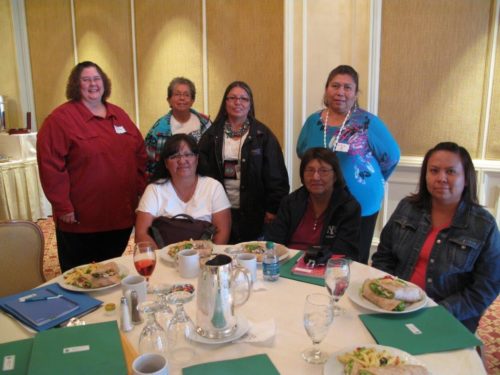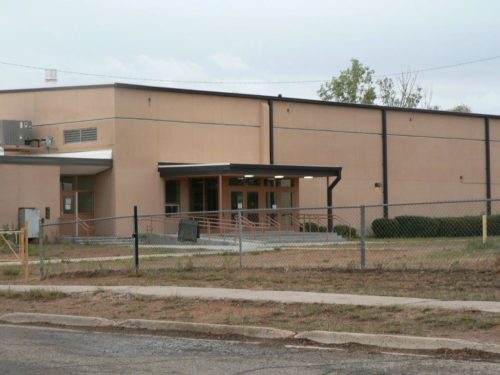Shonto Preparatory School isn’t like other public schools. Located in northern Arizona, the school is in the heart of the Navajo Nation, and serves children who are economically poor, but rich in culture and history.
Most Shonto families don’t have running water or electricity, but they take daily classes to learn a language that was first written down only a generation ago. They have little money for clothes and school supplies, but they supplement their income by making and selling the art that represents their tribal history.
“Children Incorporated helps them be able to get clothes and school supplies and food.”
Marlita has worked as the media resource officer for Shonto Preparatory School since 1996, and she works as a volunteer coordinator for Children Incorporated, helping to connect sponsors to students who need financial support.
“Children Incorporated helps them be able to get clothes and school supplies and food,” she said. “Most of the families use [sponsorship funds] for clothes and shoes, but I have one family who uses the money totally for food – so I know they’re really hurting for food.”
An Employment Desert
Shonto is an elementary, middle, and high school with just over 600 students altogether. Virtually all of them are Native American, and more than ninety percent of them qualify for free or reduced lunches.

Marlita (right) with other volunteer coordinators in Arizona
Much of the reason for this poverty is that jobs are scarce, Marlita said. There are eight or ten jobs at each of the three trading posts in the area, along with a health clinic, and the two schools — but that’s about it. Even those few employment opportunities are hard to get; the clinic employees are mostly highly-skilled healthcare workers, and the schools require a college degree of anyone working directly with children.
There’s a Walmart, a coal mine, and a power plant about an hour away, but the coal mine and power plant are both slated to close. Most families supplement what little income they have by making and selling traditional Navajo art and crafts.
Cottage Crafts
“The Navajo are extremely talented with art – any kind of art,” Marlita said. “They do painting, beadwork, jewelry, metalworking, rug weaving – and, of course, pottery.”
A few local artists earn enough to make a living at it, and a couple of them have become internationally known; but for most, arts and crafts just help to make ends meet.
Home gardens help, too, and corn is the primary backyard crop. The local species requires very little water, which is fortunate, because most residents depend on the rain, not irrigation or hoses. The local corn isn’t eaten by itself, though – it’s too tough. Instead, it’s ground up and cooked with other ingredients.
Some residents also sell food on the streets to make money. For instance, a few people sell burritos outside the school every morning.
But most have very little money, so Children Incorporated sponsors help the children receive the needed items their parents struggle to provide.
Shopping Trips
Marlita manages the shopping for those with sponsors. When the children’s funding comes in, she meets the families at Walmart, where they’re told how much they have to spend, and what it can be used for.
Each family then makes their own decisions about what they need most – shoes or backpacks, shampoo or bread – and then they meet her at the checkout line.
“I review their purchases to be sure everything is appropriate,” she said. “Sometimes I have to tell the students, ‘No, I’m sorry, that’s not acceptable.’ But for the most part, they are buying clothes and shoes and school supplies.”
But most have very little money, so Children Incorporated sponsors help the children receive the needed items their parents struggle to provide.
Marlita takes a look at their food choices, too, counseling them on nutrition as she decides what may be purchased with Children Incorporated funds.
“I tell them that pop is not okay, but juice or even Kool-Aid, I’ll accept,” she said. “Sometimes it’s hard, because sometimes the families don’t understand – it’s what they’ve been used to getting.”
Once everything has been rung up, Marlita pays for it with the family’s gift card, which was purchased with the child’s sponsorship funds.
One of the benefits to waiting in the checkout area is that she sees everyone who comes through the store, and she’s always greeted by former students.
“They’re always excited to see me,” she said. “I get to keep up with a lot of them that way.”
Of course, since Walmart is more than sixty miles from Shonto, some families can’t get there. Some send their shopping lists to Haviland, and she buys their items for them. And a few older students are allowed to do their family shopping online from the school, with Haviland’s assistance.
The children and Haviland are used to managing without direct parental involvement. Many students live with grandparents or other relatives, either because parents have had to take jobs far away, or because they’re not in the picture at all.
Cultural identity
Some families still live in the eight-sided hogans that the Navajo have traditionally built, but nowadays, most live in one-room homes made of wood or concrete blocks – though they’re little more than sheds.

An exterior picture of the Shonto school campus
“It used to be that very few kids had running water and electricity, but they’re becoming more and more common,” Haviland said. “In a survey a year ago, more of them said they have water and electricity – but not necessarily at their house; it’s often at another relative’s house they go to.”
One of the challenges faced by educators and aid workers is how to improve the children’s quality of life without erasing their cultural identity. To help maintain the children’s heritage, the school now mandates that everyone take a Navajo class every day.
Traditionally, the language is oral, and was never written down until the 1930s (which is why it was used by U.S. code talkers in World War II; since it wasn’t written, it couldn’t easily be learned by non-native speakers). When Haviland first came to Shonto, most children spoke Navajo, but not English. Over the years, however, the Navajo language has been dying out. Now, few children speak it, and few older people can read or write it.
Respecting families’ language, food, arts, and culture while also ensuring children have shoes that fit and healthy meals to eat is an ongoing challenge; but financial support from Children Incorporated makes it possible, Haviland said.
A Helping Hand
In her trips to Walmart, she watches her students learn to make good spending decisions, and get to pick out their own clothes and school supplies. And she gets to see these life lessons pay off in the form of former students who greet her as successful adults.
And she doesn’t always have to make the sixty-mile trip to Walmart to see it.
“We have former Children Incorporated students who work at the school,” she said. “One is a teacher. I didn’t know until he said, ‘Yeah, when I was a kid, I was in the Children Incorporated program.’”
“Shonto is a wonderful community,” she added. “The people are very friendly and sociable – they just need a hand.”
***
HOW DO I SPONSOR A CHILD IN Arizona?
You can sponsor a child in Arizona by calling our office and speaking with one of our sponsorship specialists at 1-800-538-5381 or by emailing us at sponsorship@childrenincorporated.org.

